
Journal of Mining and Earth Sciences, Vol 65, Issue 6 (2024) 99 - 123 99
Optimizing axial bearing capacity estimation of pre-
bored grouted planted nodular (PGPN) pile: Enriched
dataset and genetic algorithm approach
Tan Nguyen 1,*, Tuetakoun Aphistih 1, Minh The Quang Nguyen 1, Duy Khuong
Ly 2, 3, Jim Shiau 4
1 Ton Duc Thang University (Faculty of Civil Engineering), Hochiminh, Vietnam
2 Van Lang University (Laboratory for Computational Mechanics - Institute for Computational Science and
Artificial Intelligence), Hochiminh, Vietnam
3 Van Lang University (Faculty of Civil Engineering - School of Technology), Hochiminh, Vietnam
4 University of Southern Queensland (School of Engineering), Toowoomba, Australia
ARTICLE INFO
ABSTRACT
Article history:
Received 23rd July 2024
Revised 29th Oct. 2024
Accepted 10th Nov. 2024
This study introduces a practical and efficient methodology to improve the
estimation of the ultimate axial bearing capacity of Pre-bored Grouted
Planted Nodular (PGPN) piles, addressing a critical need in geotechnical
engineering. By enhancing the dataset with 98 additional case histories and
pile load test data from various projects across Vietnam, we have developed
a more reliable predictive tool for engineers. The use of genetic algorithms
has refined existing empirical formulas, significantly improving their
accuracy while remaining simple enough for hand calculations. The
proposed formula achieves a correlation coefficient of 0.907, a 7.2%
improvement over previous methods. This research offers a valuable solution
for the challenges faced in predicting the load-bearing capacity of PGPN piles,
providing a more dependable method that can streamline design and
construction practices.
Copyright © 2024 Hanoi University of Mining and Geology. All rights reserved.
Keywords:
Axial bearing capacity,
Empirical Formula,
Genetic algorithm optimiza-
tion,
Static Pile Load Test.
_____________________
*Corresponding author
E - mail: nguyentan@tdtu.edu.vn
DOI: 10.46326/JMES.2024.65(6).10

100 Tan Nguyen et al./Journal of Mining and Earth Sciences 65 (6), 99 - 123
1. Introduction
The Pre-bored Grouted Planted Nodular
(PGPN) piles represent a groundbreaking
innovation in pile foundation engineering. The
use of PGPN is growing more popular in
construction projects across Asia due to its
practical advantages in ecofriendliness and
efficiency, which have made it a preferred choice
in many construction projects (Zhou et al., 2020,
Nguyen et al., 2022). Its unique composition and
load-bearing mechanisms have spurred
researchers to develop methods for precisely
estimating its ultimate axial bearing capacity
while also addressing the challenge of minimizing
environmental impact. This section revisits the
evolution of bored PGPN piles, highlights the
complexities inherent in their load-bearing
mechanisms, reviews existing estimation
methods, and underscores the quest for enhanced
precision through innovative approaches like
genetic algorithms.
The development of bored PGPN piles began
in the 1990s, driven by continuous refinements
aimed at optimizing load transfer mechanisms
(Horiguchi & Karkee, 1995; Karkee et al., 1998).
Japanese researchers pioneered the pre-bored
precast piling method, introducing high-strength
nodular concrete inserted into pre-excavated
holes filled with cement milk. Subsequent
innovations, such as the hyper-MEGA method,
further enhanced axial load-bearing capacity by
enlarging base excavations, making these piles
highly effective in various Asian countries
(Kobayashi & Ogura, 2007).
The distinctive composition of PGPN piles
involves intricate interactions between the core
Pre-tensioned spun High strength Concrete (PHC)
pile, cemented-soil layer, and natural soils. With
this unique composition, it would create novel
load-bearing mechanisms (Yu et al., 2021; Huynh
et al., 2022). Despite efforts to elucidate these
mechanisms through analytical, experimental,
and hybrid numerical methods, the complexities
of cemented-soil interactions remain a challenge
for conventional estimation techniques. Unlike
traditional piles, the load transfer in PGPN piles is
influenced by the cemented-soil layer, which
could alter the interaction between the pile and
surrounding soil, posing a significant challenge for
the accurate prediction of load-bearing capacity.
Several methods have been proposed to
estimate the axial load-bearing capacity of PGPN
piles, each with its own advantages and
limitations. Analytical approaches, such as those
by Wang et al. (2019), used comprehensive
equations derived from soil parameters.
Experimental techniques, exemplified by Fang et
al. (2014) and Zhou et al. (2020), involved
physical testing to capture pile behavior but may
not fully encapsulate the complexities of PGPN
piles. Empirical formulas, derived from field data,
offered simplicity but may lack applicability
across diverse regions due to variations in soil
behavior (Homma, 2014; Horiguchi & Karkee,
1995; Karkee et al., 1998; Kobayashi & Ogura,
2007; Yoshimi & Tokimatsu, 1983).
To address these challenges, this study
explores the potential of genetic algorithms (GAs)
to refine empirical formulas and improve
accuracy. The decision to use GAs is driven by
their ability to optimize complex, multi-objective
problems, making them particularly suited for
tackling the intricacies of predicting load-bearing
capacities in PGPN piles. GAs, inspired by the
principles of evolutionary theory, have been
adapted to tackle complex engineering problems
by optimizing multiple objectives simultaneously.
Originating from the work of Holland and his
research team in the 1960s and 1970s, GAs mimic
the process of natural selection by representing
potential solutions as chromosomes composed of
discrete genes, each controlling specific aspects of
the solution. Initially, these genes were
conceptualized as binary digits, but subsequent
developments introduced more diverse gene
types (Lambora et al. 2019).
It is well known that engineering dilemmas
are often met with multiple conflicting objectives,
such as minimizing costs, maximizing
performance, and enhancing reliability. These
objectives pose formidable challenges, closely
mirroring the complexities encountered in real-
world scenarios. GA, as a widely embraced meta-
heuristic, is adeptly suited to grapple with such
multi-objective predicaments. It is adeptly
modified to handle multiple objectives through
the incorporation of specialized fitness functions
and strategies geared towards preserving

Tan Nguyen et al./Journal of Mining and Earth Sciences 65 (6), 99 - 123 101
solution diversity. The choice of GAs for this study
is rooted in their success in balancing these
objectives, especially in scenarios involving
complex interactions, such as those found in
PGPN piles (Huynh et al. 2022). Genetic
algorithms are particularly well-suited to handle
such multi-objective predicaments due to their
ability to preserve solution diversity and
adaptively search the solution space. This study
employs genetic algorithm to optimize the
coefficients of the empirical formula, significantly
improving the prediction accuracy of axial load-
bearing capacity for PGPN piles.
Building upon a dataset from Vietnam, Huynh
et al. (2022) developed a direct Standard
Penetration Test (SPT) method, where the
subsurface condition is represented using in-situ
SPT data. While this method is user-friendly and
practical, its accuracy was somewhat limited,
achieving a correlation coefficient of 0.846.
Subsequently, Nguyen et al. (2022) leveraged the
capabilities of artificial neural networks (ANN) to
develop a closed-form solution with a
significantly improved correlation coefficient of
0.98. Despite its accuracy, the ANN-based
method's complexity made it challenging for
practical use. Additionally, the dataset in this
study was limited both quantitatively and
qualitatively, with a scarcity of samples tested
until failure.
Despite existing methodologies, accurately
estimating axial load-bearing capacity for PGPN
piles remains an open challenge. Accurate
estimation of the axial load-bearing capacity of
PGPN piles is vital for the safe and economical
design of foundation systems in geotechnical
engineering. The empirical formulas derived
through genetic algorithm optimization provide a
practical and efficient solution, incorporating the
complexities of cemented-soil interactions. By
enhancing the dataset with more comprehensive
static pile load test data and employing advanced
genetic algorithm techniques, this study aims to
deliver a significantly improved predictive tool for
practitioners in the field. Furthermore, the study
seeks to expand the scope of this methodology,
demonstrating its potential application across
different regions and soil types beyond Vietnam.
In summary, this study builds upon previous
work to develop a more accurate and practical
method for estimating the axial load-bearing
capacity of PGPN piles. By enriching the dataset
and leveraging the power of genetic algorithms,
the new empirical formulas offer a significant
advancement over existing methods. This
expanded scope enhances its relevance to
geotechnical engineers globally, contributing to
more efficient and reliable foundation design
practices.
2. Static pile load test and dataset enrichment
The PGPN piles are composed of two main
parts: the core PHC pile and a cemented soil layer.
The core PHC pile combines nodular and
cylindrical segments, as shown in Figure 1. It has
a Young's modulus of about 40,000 MPa. The
cemented soil layer, made of pure cement grout,
has strengths of 10 MPa for the shaft and 20 MPa
for the toe, yielding a minimum compressive
strength of around 0.5 MPa. This data, provided
by Phan Vu Investment Corporation, outlines the
material properties used.
The dataset in this study builds upon the
foundation established in the work of Huynh et al.
(2022). Specifically, to maintain consistency with
Huynh’s study, the pile characteristic, material
properties, and the procedure for determining the
ultimate axial load-bearing capacity are based on
the Chin-Kondner hyperbolic law (Chin, 1970).
These aspects, having been comprehensively de-
scribed in Huynh et al. (2022), will not be
reiterated here. Instead, this study focuses on the
significant enhancements made to the dataset to
improve the accuracy and robustness of the
empirical formulas.
To fortify the foundation of our study, we
embarked on an extensive data enrichment
process. Initially sourced from diverse case
histories in Vietnam, our dataset was amplified to
encapsulate a broader range of scenarios and
geotechnical conditions. Specifically, the number
of samples increased from 81 case histories in the
study by Huynh et al. (2022) to a more robust
dataset comprising 98 case histories (see Figure
2). Moreover, the number of case histories where
piles were tested to the failure stage was
significantly augmented, increasing from a limited
number to 15 cases.
In this study, eight input variables were
utilized to predict the pile head displacement of

102 Tan Nguyen et al./Journal of Mining and Earth Sciences 65 (6), 99 - 123
PGPN piles. These variables include the diameter
of the nodular segment (Don), the diameter of the
cylindrical segment (Dc), the total pile length (L),
the length of the nodular segment (Ln), the
enlargement ratio (ω), the SPT index at the pile tip
(SPTtip), the average SPT index along the nodular
segment (SPTnod), and the average SPT index
along the cylindrical segment (SPTcyl). The
statistical properties of the dataset are given in
Table 1.
Important note: All the case histories used in
this study involve friction piles, where shaft
resistance is the predominant load-bearing
mechanism. This focus ensures consistency
across the dataset by concentrating on piles with
similar geotechnical behavior, minimizing
variations that could arise from different types of
piles or load transfer mechanisms. This
consistency is crucial in maintaining the reliability
of the data used to develop and validate the
proposed formula.
Figure 1 (a) Pile characteristics, (b) pile head, (c) pile tip (Nguyen et al., 2022; Huynh et al., 2022).
0
10
20
30
40
50
60
70
80
0 5 10 15 20 25
Pile head displacement (mm)
Load (MN)
Figure 2. Load-displacement curves of all 98 case histories.

Tan Nguyen et al./Journal of Mining and Earth Sciences 65 (6), 99 - 123 103
Variables
Unit
Min
Mean
Standard
Deviation
Skewness
Max
Don
mm
350
600
101.58
0.131
800
Dc
mm
350
600
94.11
0.245
800
L
m
22
40.50
8.00
-0.220
55
Ln
m
0
12
4.22
-1.230
12
-
1
1.18
0.08
-1.354
1.23
SPTtip
-
11.75
29.38
10.71
0.235
50
SPTnod
-
0
19.67
13.74
0.353
50
SPTcyl
-
2.45
13.05
8.13
1.714
40
Table 1 provides a comprehensive overview
of the pile dimensions and soil conditions at the
test sites. The pile diameters (Don and Dc) have a
mean of 600 mm (about 1.97 ft) with moderate
variability of standard deviations of 101.58 mm
(about 4 in) and 94.11 mm, respectively, and
near-zero skewness values. This symmetry
suggests a balanced dataset representative of
typical pile sizes in geotechnical engineering. The
pile lengths (L) range from 22 m to 55 m with a
mean of 40.50 m, showing a slight skew towards
shorter piles, while the nodular segment lengths
(Ln) exhibit a higher negative skewness, indicating
mostly shorter segments. The enlarged
excavation ratio ( as shown in Figure 1) shows
low variability and a narrow range, reflecting high
consistency across the dataset.
The soil properties, represented by SPT
values, further highlight the dataset's diversity.
SPTtip values range from 11.75÷50, with a mean of
29.38 and a low skewness, indicating symmetrical
tip resistance distribution. SPTnod values, ranging
from 0 to 50 with a mean of 19.67, show greater
variability within the nodular segment. The SPTcyl
values, with a high skewness and a mean of 13.05,
indicate lower resistance values in the cylindrical
segment. These diverse soil conditions captured
in the dataset are critical for validating the
proposed formula's effectiveness.
In comparison to the previous work of Huynh
et al. (2022), the 17 new cases expand the
dataset’s diversity by introducing a wider range of
pile diameters, lengths, embedded lengths, and
more extreme SPT values. This increased
variability enhances the model’s ability to
generalize across different pile configurations and
soil conditions, ultimately improving predictive
accuracy. Omitting or replacing these cases with
less diverse ones would reduce the dataset’s
variability, potentially decreasing the model’s
robustness. The inclusion of these cases plays a
critical role in strengthening the model's
predictive capacity. The comprehensive and
diverse nature of the dataset ensures that the
proposed formula for predicting the ultimate
bearing capacity of PGPN piles is both robust and
reliable, as evidenced by high reliability scores
across different measurement methods,
effectively accounting for the complexity and
variability of geotechnical conditions.
Figure 2 shows the load-displacement curves
of all 98 case histories. The value of the ultimate
bearing capacity is determined by identifying the
intersection of the Davisson offset line and the
Chin extrapolated load-displacement curve.
Chin’s method, based on Kondner’s (1963)
work, assumes a hyperbolic load-displacement
curve near failure. Test data from the final loading
cycle is replotted, with settlement on the x-axis
and settlement-to-load ratio on the y-axis. A
straight line is drawn from the last three points in
the plastic phase to reduce errors from early
elastic displacement, and the ultimate bearing
capacity is calculated using Equation (1).
(1)
Where: i - corresponds to the last 3 load steps;
n - the number of load levels, where n = 3, Si - the
settlement at the ith load step; Pi - the magnitude of
the ith load step.
The load-displacement curve has been
extended according to Chin’s method, as outlined
in Equation (2).
(2)
Where a and b are defined as follows:
(2a)
3 3 3
1 1 1
22
33
11
n n n
ii
ii
i i i
ii
unn
ii
ii
ii
SS
n S S
PP
Q
SS
nPP
S
S a b
P
3 3 3
1 1 1
22
33
11
n n n
ii
ii
i i i
ii
unn
ii
ii
ii
SS
n S S
PP
aQ
SS
nPP
Table 1. Statistical properties of the dataset.

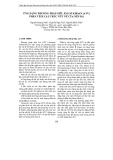
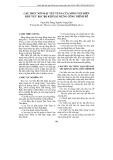
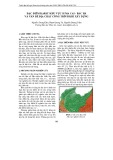
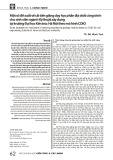
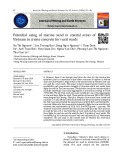
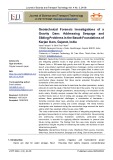
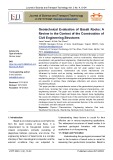






![Quy hoạch tổng thể Cà Mau: Tài liệu [mới nhất/chuẩn nhất]](https://cdn.tailieu.vn/images/document/thumbnail/2025/20250827/tghong1621@gmail.com/135x160/49401756278390.jpg)


![Bài giảng Hàng hải địa văn [chuẩn nhất]](https://cdn.tailieu.vn/images/document/thumbnail/2025/20250729/vijiraiya/135x160/43361753782101.jpg)
![Bài giảng Trắc địa cơ sở [mới nhất]](https://cdn.tailieu.vn/images/document/thumbnail/2025/20250729/vijiraiya/135x160/84_bai-giang-trac-dia-co-so.jpg)





![Atlas tài nguyên nước Việt Nam: Tài liệu [Mô tả/Hướng dẫn/Chi tiết]](https://cdn.tailieu.vn/images/document/thumbnail/2025/20250715/vijiraiya/135x160/348_tai-lieu-atlas-tai-nguyen-nuoc-viet-nam.jpg)
![Hệ thống câu hỏi ôn tập Vùng kinh tế [chuẩn nhất]](https://cdn.tailieu.vn/images/document/thumbnail/2025/20250709/kimphuong1001/135x160/76921752140578.jpg)
